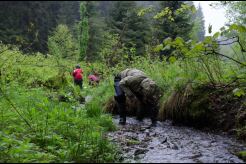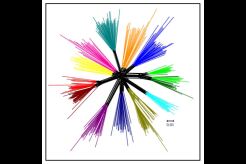Populationsgenetik
Welche Faktoren bestimmen das Vorkommen von Arten in Raum und Zeit?
Uns interessiert, wie sich anthropogene Faktoren, wie z.B. die Verbauung von Gewässern durch Querbauwerke und Verrohrungen oder die Einleitung von Schmutz- und Schadstoffen auf Populationen aquatischer wirbelloser Tiere auswirken. Wann wird der Genfluss unterbrochen, welche Hindernisse können überwunden werden und nehmen Populationsgrößen ab? Von wo werden renaturierte Gewässer wiederbesiedelt? Welche Gene oder Allele bestimmen die Resistenz mancher Populationen unter Stressbedingungen und wie schnell verändern sich diese Gene z.B. durch sogenannte selektive 'Sweeps'? In welchen Regionen und unter welchen Umweltbedingungen kommt es zur Aufspaltung von Populationen in unterschiedliche Arten?
Diesen Fragen gehen wir in unterschiedlichsten Regionen der Erde nach.
Publikationen:
Dömel, J.S., Dietz, L., Macher, T.-H., Rozenberg, A., Mayer, C., Spaak, J.M., Melzer, R.R., Leese, F., 2020. Analyzing drivers of speciation in the Southern Ocean using the sea spider species complex Colossendeis megalonyx as a test case. Polar Biol 43, 319–342. https://doi.org/10.1007/s00300-020-02636-z
Dömel, J.S., Macher, T.-H., Dietz, L., Duncan, S., Mayer, C., Rozenberg, A., Wolcott, K., Leese, F., Melzer, R.R., 2019. Combining morphological and genomic evidence to resolve species diversity and study speciation processes of the Pallenopsis patagonica (Pycnogonida) species complex. Frontiers in Zoology 16, 36. https://doi.org/10.1186/s12983-019-0316-y
Hempel, C.A., Peinert, B., Beermann, A.J., Elbrecht, V., Macher, J.-N., Macher, T.-H., Jacobs, G., Leese, F., 2020. Using environmental DNA to monitor the reintroduction success of the rhine sculpin (Cottus rhenanus) in a restored stream. Frontiers in Ecology and Evolution 8, 81. https://doi.org/10.3389/fevo.2020.00081
Macher, J.-N., Rozenberg, A., Pauls, S.U., Tollrian, R., Wagner, R., Leese, F., 2015. Assessing the phylogeographic history of the montane caddisfly Thremma gallicum using mitochondrial and restriction‐site‐associated DNA (RAD) markers. Ecology and evolution 5, 648–662.
Weiss, M., Macher, J.N., Seefeldt, M.A., Leese, F., 2014. Molecular evidence for further overlooked species within the Gammarus fossarum complex (Crustacea: Amphipoda). Hydrobiologia 721, 165–184.
Weigand, H., Leese, F., 2018. Detecting signatures of positive selection in non-model species using genomic data. Zool J Linn Soc 184, 528–583. https://doi.org/10.1093/zoolinnean/zly007
Weigand, H., Weiss, M., Cai, H., Li, Y., Yu, L., Zhang, C., Leese, F., 2018. Fishing in troubled waters: Revealing genomic signatures of local adaptation in response to freshwater pollutants in two macroinvertebrates. Sci Total Environ 633, 875–891. https://doi.org/10.1016/j.scitotenv.2018.03.109
Weiss, M., Weigand, H., Weigand, A.M., Leese, F., 2018. Genome-wide single-nucleotide polymorphism data reveal cryptic species within cryptic freshwater snail species—The case of the Ancylus fluviatilis species complex. Ecology and Evolution 8, 1063–1072. https://doi.org/10.1002/ece3.3706



